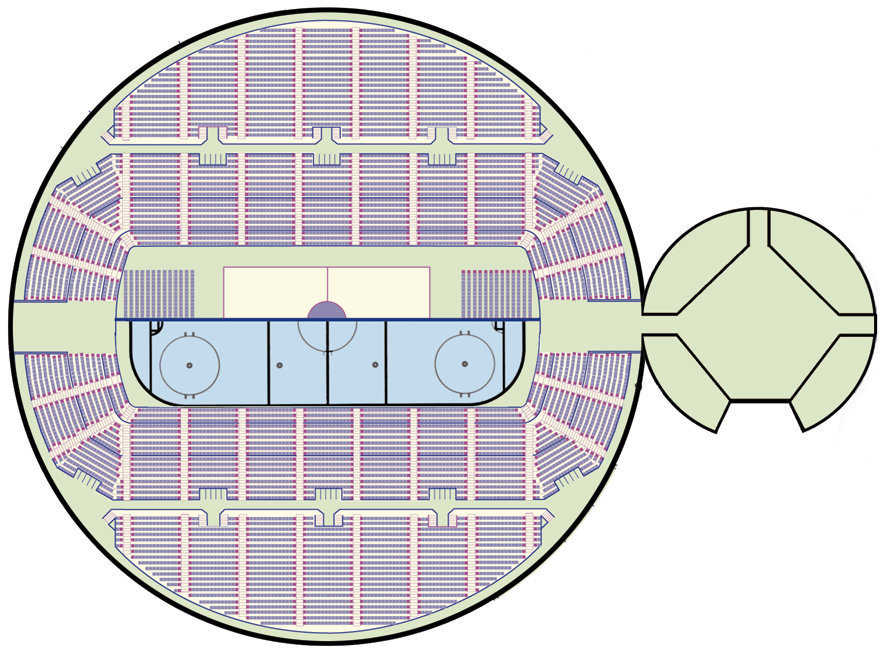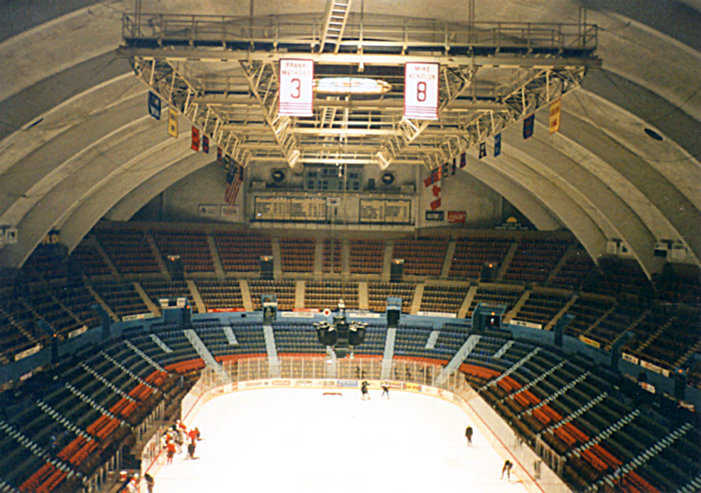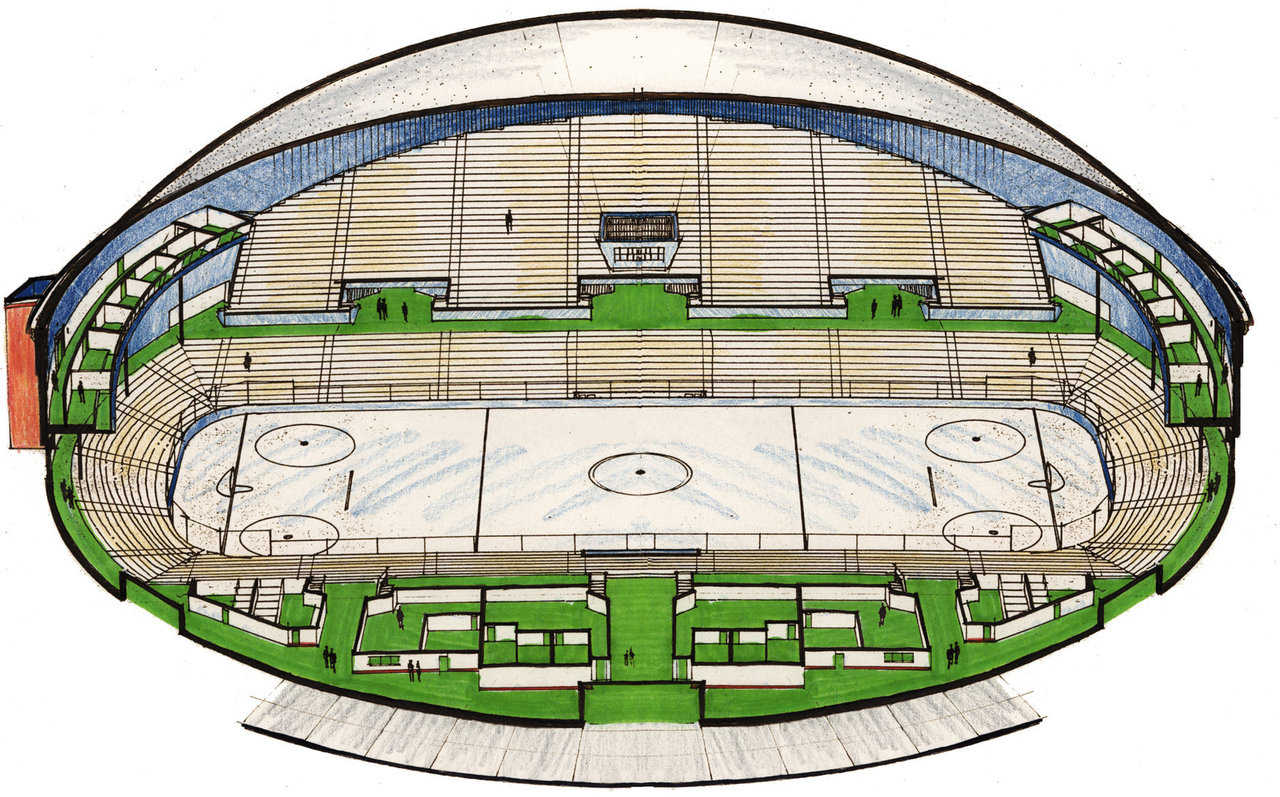Monolithic Domes = a paradigm shift in modern arenas
Built using cutting-edge technology, Monolithic Dome arenas are much more affordable to buy and operate than are conventional structures. They are multifunctional and can be designed for basketball, indoor soccer, arena football, volleyball tournaments, conventions, roller hockey, concerts and ice hockey.
Communities, colleges, universities, professional teams, and other organizations that cannot afford a conventional indoor arena, can often afford a covered, permanent Monolithic Dome arena. It adds diversity and year-round use for any venue.
Cost and Construction
The initial cost of a Monolithic Dome Arena is substantially less than that of a similar-size conventional structure. Straight forward design and simple construction makes that possible.
The key to the Monolithic Dome arena is the Airform. Prefabricated to any size using single-ply roofing material, the Airform is attached to a concrete ring foundation and inflated with air. Once under full air-pressure, the dome appears completed from the outside, but construction work continues inside.
Spray-in-place urethane foam, the world’s best insulation, is applied directly to the interior surface of the fabric form. After several inches of foam are in place, a pre-engineered grid-work of steel rebar is attached.
Shotcrete, a high-density concrete, is sprayed over the interior. It embeds the steel rebar with several inches of concrete, creating a finished structure that is extremely strong, energy efficient and permanent.
Advantages
More than thirty years of Monolithic Dome construction and analysis have proven the many advantages of our process. Most of the work is done inside, protected from the weather. The dome’s strength enables many tons of interior structure to be supported directly from it.
Energy use is reduced by more than 50 percent. This saves money in construction since less heating and cooling equipment is needed, and it saves millions in operating costs over the life of the structure.
The Monolithic Dome meets the most stringent building codes. Its fire rating is so good that a sprinkler system may not be needed (but some local codes still require it).
Arenas
A Monolithic Dome arena can include locker rooms, conference rooms, skyboxes (that may be suspended from the dome right over the playing field), retail shops, restaurants, concessions and more.
Thousands of spectators may attend a variety of games and events.
Ice Rinks
Ice sports may benefit most from Monolithic Dome technology.
Ice hockey is a special problem for many arenas. Unlike most field sports, ice sports require a controlled environment, year round, for practice and performance.
Multipurpose arenas often face a conflict between other venues and the need to practice on ice. For example, it’s impossible to practice on ice when an arena floor is covered for a major basketball championship, and some events may cover the ice for weeks.
A Core Building
A medium-size, central, core dome located between all the buildings could tie the facility together. The core dome could be simple or elaborate. It could contain dressing rooms plus a pro shop, referee rooms, offices, restaurants, snack bar, rental shops and more.
A deluxe core could have an upper deck. Visitors could walk from the upper deck to optional viewing areas suspended over the hockey rinks. It could also provide easy access to skyboxes in a neighboring Monolithic Dome arena.
By keeping the hockey rinks cold and the core building warm, the best use of energy equipment is obtained. In winter, excess heat from the ice compressor can be utilized to heat the center core.
Staged Construction
A complete hockey facility can be built in stages, with a practice rink including temporary dressing rooms as Stage One. Next a core building and a second rink. Later, a third and fourth rink can be added. In some instances an arena can be added, or a practice rink can be added to an existing arena.
Feasibility Study
A Feasibility Study is a preliminary study comparing the Monolithic Dome process to other building systems. It defines the design and intent of the project and provides an estimated budget. It also assists with preliminary plans to help with financing.
For our clients, Monolithic will produce a feasibility study before architectural services are engaged. This study will not provide plans for construction purposes, but will includes a preliminary design, code check, site plan, budget and simple rendering. It’s well worth the cost.
Conclusion
A Monolithic Dome is the ideal choice for a column-free arena and practice facilities. It combines a superior building with an affordable design. Many problems with current sports facilities can be eliminated. And energy savings can pay for the entire complex during its lifetime.
Please contact us with your questions and concerns: mail@monolithic.com or 972-483-7423.
Note: Reprinted from our Fall 1997 Roundup
Updated: September 2011

Huge Arena — Monolithic’s plans for an arena with a 9,000 seat capacity can include shops and services. A small dome can contain the Zamboni and ice plant for the practice rinks.

Monolithic Multi-Rink Arena — In a Monolithic Dome arena, energy use is reduced by more than 50 percent. This saves money in construction since less heating and cooling equipment is needed, and it saves millions in operating costs over the life of the structure.

Hersheypark Arena — Thomas C. Stephens, Director of Operations for the Arena wrote this letter of recommendation based on his experience with the oldest thin-shell, concrete stadium in the country:
“When Hersheypark Arena was constructed in 1936, it was considered to be one of the finest buildings of its time. Now, 60 years later, it has withstood the test of time. The Arena is an oval shaped, monolithic, reinforced concrete structure that will last into the future. Hersheypark Arena, with seating for 7,350 has been home to hockey since its construction. This unique structure has hosted many events over the years, with one outstanding feature – not a bad seat in the house.
“The idea of a Monolithic Dome ice facility . has improved the design concept. Water penetration into our concrete and expansion joints is our biggest concern in building maintenance. Those problems do not exist with this design. Anyone looking to build an ice arena should be impressed with the design, energy conservation, safety, and the unique openness of these structures. Once constructed, you can count on having a great facility for many years to come.”
Sincerely,
Thomas C. Stephens
